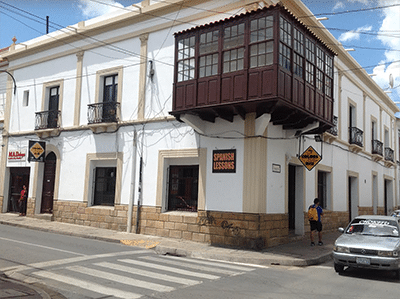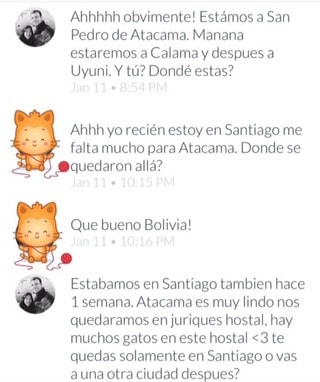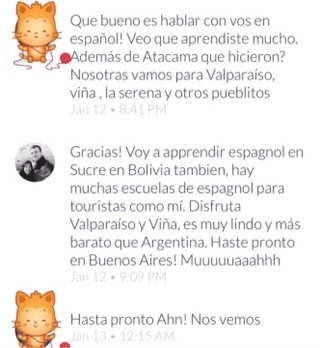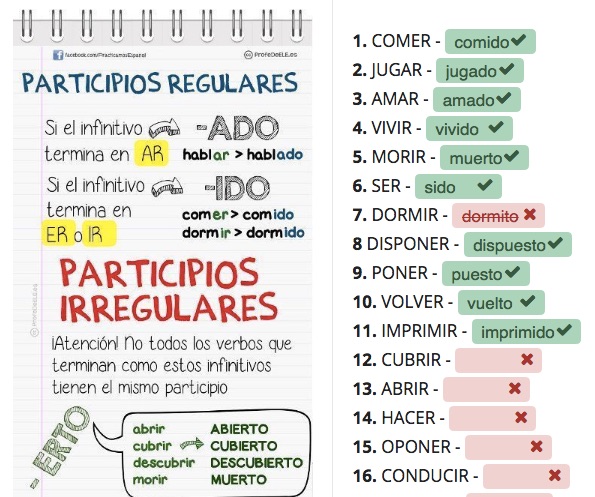
Learn Spanish in one month to travel in South America: Tips, Tricks, Addresses
Even before I left on my round-the-world trip, everyone was telling me that I had to hurry up and learn Spanish. Unfortunately, I couldn’t get started before, so I had to learn Spanish in express mode, just one week before arriving in Chile. Speaking a bit of Spanish is a real advantage here, since it was clear that few people spoke English here, even at the tourist office
I found thatin one month, one could acquire enough vocabulary and grammar to travel safely in South America and deal with all situations related to travel. In addition, the French have the advantage of having a grammar and words quite close to Spanish
Depending on your time and budget, you can choose the method that suits you best, or even combine the two methods
Method 1: Learn Spanish without a teacher
Method 2: Learn Spanish with a teacher
Method 1: Learn Spanish without a teacher
I don’t know about you, but for me, French-Spanish conversation books aren’t at all enough. If you are able to memorize sentences but don’t understand the structure and grammar, you quickly get stuck. If you can’t understand the structure and grammar of a sentence, you’ll soon get stuck. If the answer is different from the one in my conversation guide, I’ll get lost. For me, grammar is the base. Vocabulary and sample sentences will follow. So I propose the following program for one month
- One week before the trip: Start with the Michel Thomas Method Spanish Beginner (at least the first 2 CDs, out of the 7)
- 2-3 days before the trip: Complete your vocabulary and improve your oral comprehension with the MosaLingua application
- During the trip: Improving listening comprehension with podcasts – Free of charge
1. Michel Thomas Method: acquiring the basics of grammar and structure
The pitch
A new original and dynamic presentation for this innovative and high-performance 100% audio method that has already proven itself to millions of people around the world
Progressive, pedagogical and efficient
– Builds user confidence through the similarities of the foreign language to French
– Allows the user, after only a few hours of active listening, to acquire the knowledge and confidence necessary to understand and master Spanish in all its complexitiesUnpublished
– The user actively participates in a private lesson in which the trainer addresses him/her and two other students.
Michel Thomas has dedicated his life to learning and teaching foreign languages. He is the one who taught French to Grace Kelly. His method is based on building the student’s confidence very quickly, by first teaching words that resemble the student’s mother tongue, followed by very easy explanations of grammar. The real Michel Thomas method is recorded at the base in English (by Michel Thomas himself). Fortunately, a French version has been created by Harrap’s. Thus, the method I am talking about is entirely in French, with comparisons between Spanish and French
This method consists of simply listening to a few CDs, the author specifies that no book or note-taking is required, nor is it necessary to try to memorize. The best way to learn is by repeating the translation of the sentences several times and by being relaxed
The plusses
- With the first 3 CDs (out of the 7 at the beginner level), you can already formulate a lot of sentences and reach level A1
- Since it’s an audio method, it’s great for making the most of your travel time.
- Fictional students really suck, but it gives me more time to think about the answers and memorize better.
- As we are about to forget a word or verb, we are magically asked to translate a sentence containing that word/verb.
- The conjugation is explained in a super innovative way, instead of presenting us with 1000 cases of exceptions, we are presented with 3 groups max, the regular verbs, the “gogo” verbs and the others.
- We learn to conjugate for the subjects we really need, i.e. for: yo, usted (el/ella), nosotros, ustedes… the method doesn’t care about tú and vosotros , which aren’t really used in South America (people are very eager).
The –
- You still have to be super concentrated when you listen to these CDs, otherwise you won’t retain much. It is advisable to listen and listen again to the CDs several times, until it goes in
- We only translate sentences into Spanish -> we will speak well with this method, but the oral comprehension isn’t emphasized
- Here we learn structure and grammar, not the most commonly used words for travel. No one will teach you how to count, or how to ask the time in this method.
For listening to all three methods: Beginner, Advanced and Vocabulary, I recommend that you buy only the Beginner method
Indeed, the Perfection method consists in learning: the imperative, the simple past tense, the subjunctive, the imperfect subjunctive. Basically, only things that aren’t indispensable in the context of a few months’ trip to South America. The Vocabulary method consists in teaching us to guess Spanish words that resemble French. In addition, you need to have listened to all of the “Beginner” CDs or even part of the “Advanced” method in order to be able to translate the sentences proposed by the Vocabulary CDs. Much too much work for not much.
Link
The Harrap’s Michel Thomas Spanish Beginner Method is available on Amazon, and costs between 62€ and 75€ for 7 CDs
2. MosaLingua application: acquire vocabulary and improve listening comprehension
The pitch
Finally an application to learn Spanish efficiently!
Memorize Spanish vocabulary easily and quickly with a scientifically recognized method
Improve your pronunciation, learn Spanish conjugation and grammar through the lessons and the SRS system (the SRS system is a scientific method that determines when to remember a word before you erase it from your memory). Thus, you only need to learn 5 to 10 minutes/day)
You’ll also be able to improve your speaking skills with the built-in dialogues and make progress in Spanish!
The plusses
Unlike the Michel Thomas method, this app does not cause any structure or grammar. It is an excellent method to acquire vocabulary (you learn new cards every day); and to improve your oral comprehension
I wanted to insist on the oral comprehension part because that’s what I was missing with the Michel Thomas method. With Michel Thomas, the only Spanish speaker is the teacher. You get used to his accent, which is very understandable. With MosaLingua, the cards (a card = a sentence or a word) are read by several voices (female and male). Before giving the meaning in French, the card is first read to us in Spanish. Thus, if it is a word or a sentence that we already know, it is an excellent listening comprehension exercise
One must go through 4 steps before completing a lesson (consisting of 5 cards minimum). This allows us to work on the 4 parts: pronunciation, listening comprehension, writing and reading
There are also entire conversations with transcripts, corresponding to everyday situations: hotel reservations, restaurant orders, requests for information at the tourist office… which serve as conversation guides for travelers like me
I particularly like the “hands-free” feature, where we are taught 50 cards in one hour. This is especially useful when you want to learn Spanish during transportation
There are many other features that I won’t talk about here, I invite you to visit the official website of the app
The –
- As I said, there is no grammar or structure, you have to pay extra to access this part
- Words learned via the “hands-free” function aren’t counted as learned. You have to repeat the 4 learning steps or go directly to “Auto evaluate memory” to have these cards counted by the system
Link
You can learn with MosaLingua on your computer, iPhone or Android. The application costs 4,99$, the Web version 60€/year
Mosalingua contacted us to propose you a promo code (it’s an exclusive offer for you, we don’t get any bonus). By clicking here and using the code MOSATOUR-20 you will get an annual subscription for the Web version: 47,93 € instead of 59,90 €. Don’t hesitate to take advantage of it!
3. Podcasts: improving listening comprehension
There are 2 podcasts that I like very much
- Learn Spanish with Espagnolpod
- Coffee Break Spanish
Learn Spanish with Espagnolpod: is a podcast for French speakers. Every day, Louis reads us a super complicated sentence. He will explain the meaning of each word, followed by a specific example. At the end of the 3-minute lesson, he will reread the beginning sentence. Miracle: we understand the whole sentence now, even if it has never been translated into French. Louis also gives Spanish lessons via Skype. Don’t hesitate to contact him here
Coffee Break Spanish: is a Scottish podcast. The lessons are therefore given in English (with a nice accent as a bonus). Mark gives Kara, a Scottish student, lessons in Spanish. The rhythm is slower than with the Michel Thomas method, for example you can easily spend 20 minutes learning the conjugation of the verb “trabajar” in the present tense. Every 5 lessons, there is a recap lesson, where Mark interviews someone in Spanish, using the words learned in the previous lessons, and then Mark and Kara analyze the conversation, highlighting a few new words. This is terribly effective for listening comprehension. It’s very fun too, we even get a few songs
However, if you don’t speak English well, move on, it’s hard to learn a foreign language from another foreign language
Coffe Break Spanish also sells course materials on Amazon Kindle or via its web platform but I find it isn’t necessary to buy any
Results after one month
I’ve talked about it at length here. The balance is very positive, I understand a lot of things and can speak well. After a month
- i learned 300 cards via MosaLingua
- i listened to all the CDs of Michel Thomas’ Beginner’s method (7 in all, about 7h30 of listening)
- i listened all season 1 of Coffee Break Spanish & 20 SpanishPod lessons
All this on my commute time, or a few minutes before going to bed. And I find that it’s enough to get by on a daily basis (I slowed down the pace of learning afterwards, by the way)
Below you will find the conversation I had with an Argentinean girlfriend. Even if there are some mistakes, you can see my level after a month of total immersion in South America and after using the different learning methods mentioned above
Method 2: Learn Spanish with a teacher
We are in February 2017, 2 months after my arrival in South America. My learning pace has slowed down significantly, as I now understand most of what I am told
However, I still finished Michel Thomas’ 3 methods (beginner, advanced and vocabulary). I want to go further. Speaking Spanish fluently has always been my goal. That’s why I decided to spend a week in Sucre (Bolivia) to learn Spanish with a teacher
Which country to choose?
The recommended countries to learn Spanish in South America are: Guatemala, Peru, Colombia and Bolivia; where you can find a nice accent and a naturally slow speech speed
Among these countries, we only travel to Peru and Bolivia and the rates in Bolivia are the cheapest in South America, especially in Sucre, a student city, where private classes start at $6/hour and group classes start at $4/hour
Argentina and Chile are obviously not recommended. In these countries, pronunciation isn’t a model to follow. There are some Chilean Spanish enthusiasts who say that if you are able to understand Chilean Spanish, you will be able to understand any Spanish
Which school to learn Spanish in South America?
There is no shortage of schools in Sucre, just search for hostels that offer both accommodation and Spanish courses. However, three schools stand out
- Me Gusta Spanish School ($6.5/hour, private lesson)
- Open Spanish School (6$/hour, private lesson)
- The Bolivian Spanish School ($6.5/hour, private lessons)
They look pretty much the same, with
- a playful learning method (the last hour of class can end at the mercado central)
- experienced, English-speaking teachers
- the possibility of finding a host family where you can practice more Spanish
- group outings to learn how to cook, visit the tour or the surrounding area
- volunteer activities when you reach a certain level of Spanish
Note: the alliance française also offers Spanish courses starting from 40 bolivianos (private lessons) but I have not read the reviews
I chose “The Bolivian Spanish School”, nestled in Colors House, because it is the only one open for registration on Sunday (the day we arrived in Sucre)
 When you take classes and stay at the school hostel, you are entitled to some discounts. That’s how I got the rate of 40$B per hour of private lessons (5,7$/h), and 140$B for a double room with breakfast. For a total of 20 hours of classes over 5 days. If I want, I can also take lessons on Skype later
When you take classes and stay at the school hostel, you are entitled to some discounts. That’s how I got the rate of 40$B per hour of private lessons (5,7$/h), and 140$B for a double room with breakfast. For a total of 20 hours of classes over 5 days. If I want, I can also take lessons on Skype later
It’s the low season, we are only 3-4 students, there aren’t too many group activities at the moment
JB, who does not take courses, can take advantage of the courtyard of the hostel, super quiet, to work. There is also a large kitchen within the hostel, and a restaurant just on the 1st floor
How the courses take place
Before I take classes, I am given a written test, which I passed. I combine rather well and know quite a lot of time thanks to the Michel Thomas method. My concern is the mastery of irregular verbs
Every day, and for 4 hours (from 8:30 am to 12:30 pm), I meet my teacher Mirina for 2 hours of conversation and 2 hours of grammar, with a 15mn break. The lessons are of course personalized because they are private, I could have reduced or even totally eliminated the grammar if I wanted to. To “make the teacher’s trip profitable”, you need to take at least 2 hours of classes/day – and at most 6 hours/day (this is ultra intensive learning for the most motivated)
We speak very little English, except in case of total incomprehension. The most important thing is that I can take advantage of this opportunity to ask him a lot of questions about Bolivia. The 4 hours go by very quickly, I don’t feel washed out after class
She asks me questions in Spanish, using different tenses and verbs, which I have to answer. At first, I had difficulty determining (1) who she was talking about (2) what verb she was using, but I am progressing very quickly. She always encourages me to answer her with a complete sentence, adding as much detail as possible. My oral comprehension has improved a lot thanks to these 2 hours of daily conversation
When learning grammar, we alternate between learning and practicing every 5 minutes. This way, I won’t risk forgetting what I have just learned. There are also exercises at home (mainly writing), corrected in the next class
Additional exercises
Since I have the time (one week to learn only Spanish), apart from the exercises given by Mirina, I take the opportunity to do a lot of other grammar exercises. I found a very playful site, ProfedeELE, with games and corrected exercises. You need a computer though, because it’s laborious to enter the answers on a smartphone
Results
Here is a little text I wrote after 8 hours of class (click on the picture to zoom) + the teacher’s correction in red
Conclusion
Whether you are learning Spanish with or without a teacher, I encourage you to LEARN SPANISH for your trip to South America. For your safety and also for the pleasure of talking with the locals in their native language
Learning Spanish with a teacher is the fastest way to learn Spanish. However, I’m glad I had a basic knowledge of Spanish before I did it. Because even though the rates in Sucre are the lowest in South America, paying 6$/hour when you can learn a lot on your own is a real waste. I would have sulked if I had to pay that much to learn how to conjugate verbs in the present tense
However, I would have liked to start the course in Sucre a little earlier, 3 weeks after my arrival in South America for example (instead of 2 months), because I find that after 3 weeks – 1 month, I get lazier to learn Spanish on my own
To know
And finally, here is the list of the most important things to know for your stay in South America
Buenos dias/Buenas tardes/Buenas noches/Gracias/De nada/Disculpe/Cuanto cuesta?/Con permiso/Por favor/Quisiera + indicative verb or noun/Puedo…/Soy de Francia/Nombre/Apellido
The conjugation of these verbs in the indicative present tense, the past tense and the near future for yo, usted, nosotros and ustedes
SER – ESTAR – IR – HACER – TENER
This very used structure: HOLD THAT = duty (I have to do this, do that) / HAY… = there is..
Know how to count from 1 to 1000
Left(izquierda) – Right (derecha) – Right (recto)
Some verbs that come up often: pagar (to pay) – caminar (to walk) – to dirty (to go out) – reservar (to reserve) – limpiar (to clean) – comer (to eat) – beber (to drink) – necesitar (to need, to need) – to hear (to understand)
For the rest, download Google Translate and dicos to your smartphone and translate as you go.










